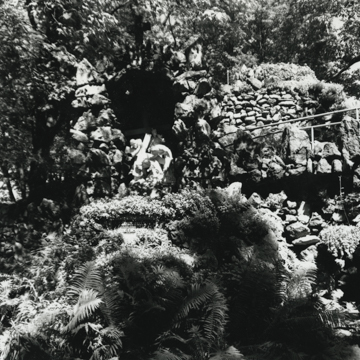Rudolph Grotto is a naturalistic sculptural environment and botanical garden on the grounds of St. Philip the Apostle Church and School. It was created by the Reverend Philip Wagner over a period of more than three decades. Within the four-acre Grotto Gardens are paths that meander through a lush setting of trees, shrubs, ferns, flowers, and ivy, with constant changes in elevation giving the impression of a journey through a wooded mountain terrain. It is best visited in the summer, when the flowers are in full bloom.
Wagner developed the grotto to fulfill a promise he had made to the Virgin Mary during a pilgrimage to Lourdes, France, to restore his health. In 1919, he began to develop a landscape plan, and in 1927, assisted by his lifelong assistant Edmund Rybicki, he commenced work on the first of many shrines, a replica of the Lourdes grotto consisting of a marble image of the Virgin inside a rocky oval. As naturalistic as this setting appears, it is entirely the product of Wagner’s artistry. A lover of nature, he originally envisioned a natural setting on the side of a hill, but he had only flat farmland to work with. So he created a varied topography, laid out a path, and used rust-colored gossan, a locally quarried, volcanic-looking rock, to build caves and shrines at every rise and turn in the trail. The caves and niches vary in size from miniature to monumental, but each one contains religious statuary carved of Carrara marble.
The central work in Grotto Gardens is the Wonder Cave, a fifty-foot-tall craggy hill constructed of gossan rock and concrete. Its surface is planted with a rich cover of flowers, vines, and other vegetation. The interior, moist and dark like a natural cavern, is an undulating concrete passageway that stretches one-fifth of a mile and in some sections measures less than three feet wide by five feet high. Around each curve appears a religious diorama, dramatically lit. Biblical verses and moral exhortations are spelled out in hammered tin spangles. Passing through the small, cave-like space, a visitor is meant to encounter each scene with a sense of awe, so that the overall impression is one of religious mystery. The cave’s path eventually emerges from the side of the artificial landform, reaching a fork. One can then follow the path up and over the hill by twists and turns, or descend into Grotto Gardens.















